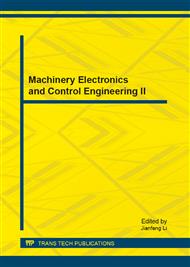p.932
p.937
p.941
p.946
p.950
p.957
p.962
p.967
p.971
A Toy Robot via Cam Design as a Balance Module of Gravity Shifting
Abstract:
This study presents a brand new concept in contrast to that of the conventional mechanical toy robots on the market. Conventional toy robots rely mainly on a large sole area to reduce wobble during walking. In this study walking stability is realized not by large sole areas but by a cam designed to automatically shift the center of gravity during walking. The biped toy robot proposed is driven by a single motor. As soon as the robot takes a forwards step, the center of gravity is changed by the cam module, and under the action of gravity, the trunk moves automatically to shift the center of gravity. Both walking and shifting the center of gravity is done by one motor. It was a goal of this study to develop a new type of walking toy robot by modifying traditional toy design. Experiment and simulation revealed that the rotation speed of the crank influences the walking of the biped toy robot, and the crank length influences both the length and height of the stride. In addition, counterbalance of the robot while walking is affected by the location of the center of gravity of the trunk and the distance between the feet. It became clear that the stability of the walking robot was determined by many factors, and difficulties may arise if any of these factors is changed.
Info:
Periodical:
Pages:
950-953
Citation:
Online since:
March 2013
Keywords:
Price:
Сopyright:
© 2013 Trans Tech Publications Ltd. All Rights Reserved
Share:
Citation:


